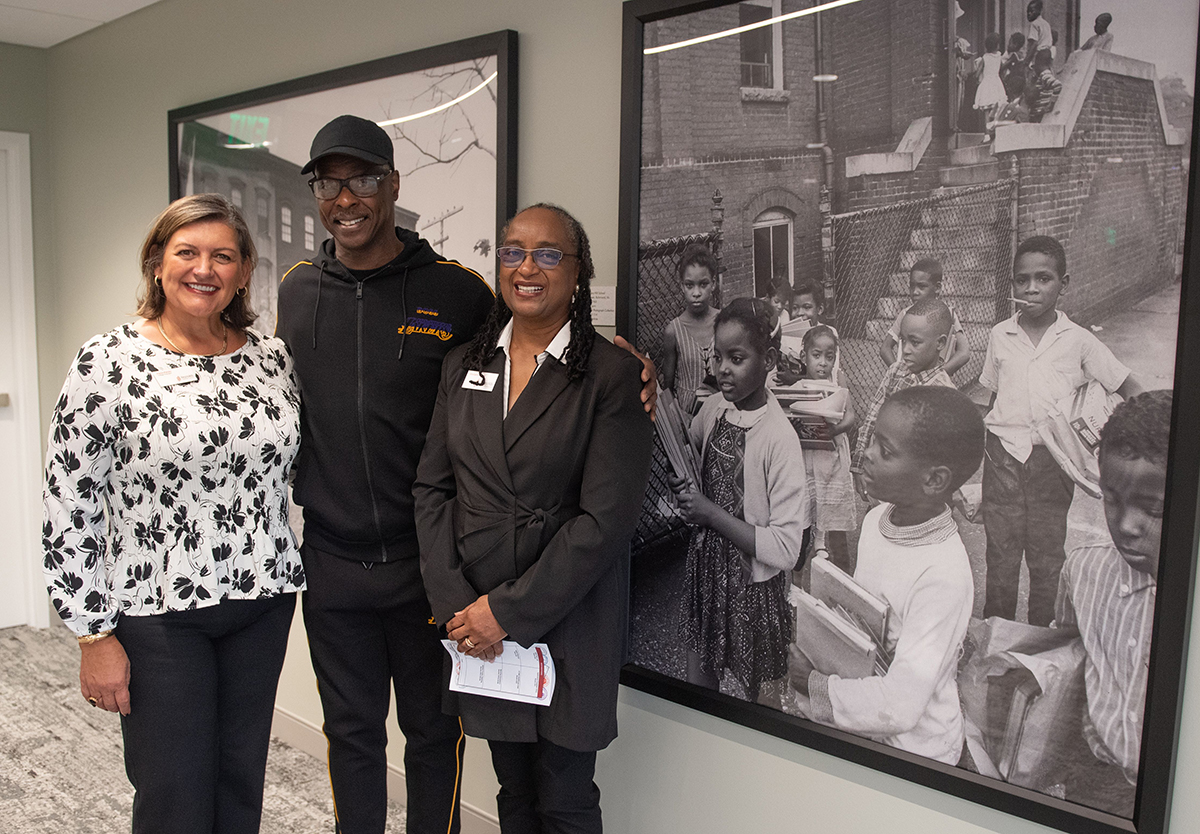Navy Hill, Remembered
Reynolds employee Georgette Harris's jaw dropped as she watched a video distributed to faculty and staff at Reynolds Community College. The video, in which President Pando and Mayor Stoney discuss a partnership between the College and the City of Richmond, pans across the newly renovated Community Room at Reynolds' Downtown Campus. Three prominent photographs of the Navy Hill neighborhood dominate the initial footage and take center stage in the room.
The photos, especially the central one, brought back a flood of memories for Georgette. The photo features the bright faces of school children, books in hand, outside the Navy Hill School in 1965. None of their expressions tell the story of what was actually taking place, and they no doubt were unaware of what was really happening, or the ramifications of their school being closed.

Dr. Pando with Clayton Jones and Georgette Harris in the Community Room in front of the photo from 1965 of the Navy Hill students on their last day before the school was closed.
The faces Georgette knew so well were her own brother and sister, Clayton Jones and Ella Jones Winfree, both elementary school students at Navy Hill School. Georgette and her siblings began their lives on 3rd Street, in the Navy Hill community. The 1960s brought turmoil to their family as the thriving African-American neighborhood was wiped out in the name of progress, leaving families dazed and confused.
Under the authority of eminent domain, families received meager compensation for their properties and were instructed to vacate. Homes, businesses, and stores were forcibly shut down, and Navy Hill School was shuttered. The neighborhood, where countless individuals had spent their entire lives and childhoods, was ultimately razed to the ground.
The story of development and the building of Interstate 95, bisecting the community, is a dark stain on Richmond’s rich history. That decision and the choice to close Navy Hill School was tinged with unfairness, as it disproportionately impacted a historically marginalized community, robbing generations of children of a quality education and the sense of belonging that the school provided.
Now, Georgette works at Reynolds, whose Downtown Campus sits in the footprint of the once vibrant Navy Hill community. She and her brother, Clayton, who was the young boy, front and center in the photo, recounted their story. They told of how the closure of Navy Hill School left a void in the community, as it had represented not only a place of education but also a symbol of tradition and heritage.
“This neighborhood was like a big family. But when they decided to develop the area, everything changed. Homes, restaurants, grocery stores, barbershops, the school – all erased in about two months’ time. That happened. And we wondered, ‘what would happen next?’"
Navy Hill School held a unique place in Richmond’s history, its roots dating back to the late 19th century. The only school in Richmond with black faculty members, it served as a vital center of education for the community for many years. The school had been a symbol of educational empowerment and a beacon of hope for the African-American residents in the neighborhood. Its closure was met with profound sorrow and frustration in the community, as it represented not just a place of learning but a vital hub of cultural pride and unity.
Clayton has no memory of that day; “Other than a feeling of nervous apprehension and not knowing what to expect, I don’t really recall the details of that day.” Much the same as memories fade with people who suffer trauma. The trauma is still there, but the memory of the cause grows dim. Both he and Georgette were emotional, wiping away tears, as they stood for photos and told their story.
As part of the Reynolds family, Georgette now dedicates her time here as an Education Support Specialist working in the Program for Adults in Vocational Ed (PAVE).
“I’m happy to be here and be able to talk about this. I’m proud of being part of Reynolds and seeing what Dr. Pando and the college are doing to raise awareness, provide training, education, and all types of support to uplift the community.”
At Reynolds, we know it’s difficult to bring to light the injustices of the past, but it’s crucial that we bring awareness and attempt to rectify the damage created in the name of development to help heal the community.
Reynolds proudly opens its doors with a heartfelt commitment to recognizing this once-thriving neighborhood. In acknowledging the historical significance of Navy Hill and its vibrant past, the college seeks to be a catalyst for positive change.
Today, the Reynolds newly renovated Community Room sits on the sixth floor of the Downtown Campus, overlooking Interstate 95, northward. This new multi-purpose meeting space is styled with these large photos that serve as a reminder of the Navy Hill neighborhood that once was. The photos tell the story of the vibrant neighborhood that once occupied this space.
Dr. Pando’s passion for community is evident, and as she told Georgette, “Reynolds is not only of the community, we ARE the community.”
By providing accessible education and workforce development programs, Reynolds aims to empower residents with the skills and knowledge needed to rebuild and reinvigorate the community. Through partnerships with the city, local organizations, and outreach initiatives, the college strives to foster a sense of unity and purpose. In doing so, Reynolds embodies the spirit of giving back and hopes to play a vital role in remembering and paying homage to this historically significant and resilient community.